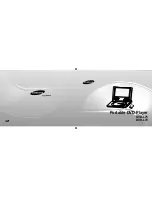
Page 6
60706-133
8290-01
7. Check all electrical connections in the system to be ener-
gized by the generator. Make sure the connections are cor-
rect and are tight.
8. Make sure all loads are turned off. Do not start the genera-
tor under load.
GENERATOR STARTING PROCEDURE
1. With the power take-off drive disengaged, start the engine
which will drive the generator. Run the engine long enough
to warm it up before proceeding, so that it will run smoothly
and achieve full power under generator load.
2. With engine idling, engage the power take-off drive.
3. Watch the voltmeter on the generator and slowly increase
engine speed until the output reaches approximately 260
volts, in green portion of voltmeter scale.
4. With engine and generator running smoothly, switch on
the electrical load while watching the voltmeter.
NOTE: Equipment Damage
If the load includes motors turn them on one at a time, highest
starting current motor first, next highest second, etc.
Readjust engine throttle to keep generator output under load
at 240V (in green portion of voltmeter scale). If engine is
equipped with speed governor, it may automatically readjust
the throttle as the load changes and keep the generator output
at the proper level. However, some governors are not sensitive
enough to maintain proper output under changing load, and in
such cases the throttle will have to be manually readjusted .
GENERATOR SHUTDOWN PROCEDURE
1. Switch off electrical load.
2. Reduce speed of engine driving generator to idle.
3. Disengage power take-off drive, and allow generator to
coast to a stop.
WARNING: Personal Injury
Never try to manually stop the generator. Always let it coast
until it stops.
5. Shut off the engine.
4. Disconnect drive shaft (tumbling bar)
power take-off end first, then generator end.
Figure 6
Figure 7
3. Make sure the drive shaft (tumbling bar) is assembled with
its universal joint knuckles “synchronized,” as illustrated in
Figure 7. If knuckles are not synchronized, the bar will chat-
ter when rotating, which will cause the generator output
voltage to flicker.
DANGER: Personal Injury
POWER TAKE-OFF MUST BE DISENGAGED AT THIS TIME.
4. Couple the tractor to the generator with the drive shaft (tum-
bling bar). Couple the tumbling bar to the generator input
shaft first, then to the power take-off shaft. Check align-
ment, tractor, power take-off shaft (tumbling bar), and gen-
erator input shaft should form a straight (or nearly straight)
line, with less than 15° misalignment between the shafts.
Misalignment will cause generator output voltage to flicker.
CAUTION:
Make sure that all tumbling bar lock pins are engaged and
that all safety shields are in place before operating the PTO
generator.
5. Make sure no binding exists in generator or gear box. If
binding is found, locate the cause and correct it before pro-
ceeding.
6. Make sure that the electrical loads to be driven by the gen-
erator will not draw more current than the ratings of the
generator receptacle or cord set which will supply the cur-
rent.






























